News
Zero Waste, every small change helps. October 24 2019
The best option for people is to get your coffee fresh from a local roaster, so now that we’ve settled into our new gaff in Balbriggan, we’re ready to do our bit to help you move to zero waste. The smartest way to reduce waste in your home is to eliminate the amount of excess packaging coming in, so we are hoping that all you lovely people will pop into the roastery shop, bring your own containers, and fill up with our beautiful coffee. Don’t be shy and pop in, every small change helps.
Exciting News August 23 2019
We have moved our great Roastery to the brilliant town of Balbriggan. We have added a retail section that you can purchase coffee, beans, equipment everything you need. Check us out at Unit 10 Balbriggan Business Park, K32K571...... Come and check us out. We look forward to seeing you.Grab some Two Spots retail coffee in the wonderful Evergreen October 24 2018

You can now grab one of Two Spots Coffee blends in Evergreen on Wexford Street D2. Also pop in and see the fantastic range of fresh products they have.
Check out Feast in Castle Way, Golden Lane, D8, serving Two Spots Coffee! October 01 2018

Check out Feast in Castle Way, Golden Lane, Dublin 8, Ireland serving Two Spots Coffee and fabulous food.
Summer Series June 23 2017
We have decided to do things a bit differently for this summer. We have released the June, July and August monthly single origins at the same time and given you the option to purchase all three together at a discounted price. It also gives you the chance to taste different coffees and expand your coffee knowledge.
For June we have chosen the fruity coffee Sidamo from Ethiopia, July's single origin is the balanced Topacio from Mexico and August brings the sweetness of Bora that is sourced from Kenya.
If you have any queries contact us here

Colombian Single Origin Coffee is now SOLD OUT May 23 2017
We hope everyone who got to taste this fantastic coffee enjoyed it and hopefully we will be able to source some more in the future.
Keep an eye on our blog or facebook/instagram/twitter to stay up to date with all of our news and if/when we will have the Colombian single origin back in stock.
Limited Availability Colombian Coffee April 27 2017
Available in the store from the 3rd of May 2017
and from 1pm on the 1st of May for anyone who has signed up for our newsletter.
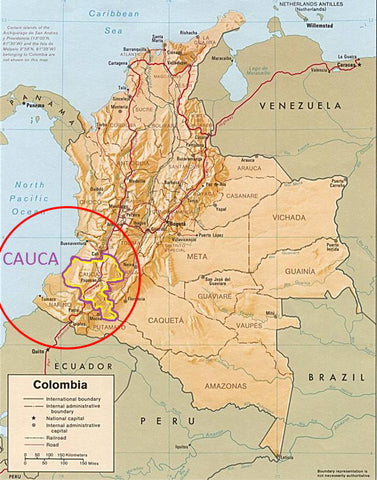
We have a special single origin coming to us this May. It is Colombian coffee from the region of Cauca, grown on a reserve called Munchique Los Tigres. This reserve is run by an association called Nasa Pkakjera Uss Ya Txnxisa (NAPUY) its main goal is the recuperation of indigenous culture within in the area. The association boasts 129 families who grow coffee for export. Munchique Los Tigres is nestled in among the mountain range of Cauca at 1500 - 1900 meters above sea level.

Coffee is not the only thing grown in this area though which is the reason for its distinct and delicious flavours. Throughout the area sugar is grown, in particular a sugar called 'panela' and it's safe to say that the coffee exhibits that sweetness in both the aromas and flavour. Additionally, in amongst the coffee trees fruit is grown; lending its flavours to the coffee. Plantain, pineapple, lemon and oranges are the most commonly grown crop in conjunction with coffee.
We only have limited availability of this coffee at this current time but hope to be able to source more in the future.
To keep up to date with our news, receive priority access to products, get discounts and deals join the army of Two Spotters by signing up to our newsletter below. If you would prefer to be manually added, email info@twospotscoffee.ie with your name.
.
The Cold War - 10 Reasons to Love Cold Brew Coffee March 23 2017
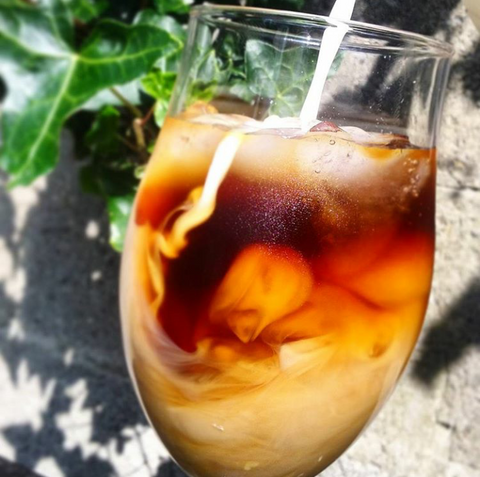
Cold Brew... the stuff made of nightmares for the folk who like their Caramel Macchiatos with extra syrup and one shot of coffee. Who ventured in to a coffee shop on a hot day when the Sahara was taking up residence in their body only to be convinced by their weird friend who always wears black and drinks coffee out of those filter machines to order an Iced Caramel Macchiato and then swore that their life on this earth was not worth the pain of cold coffee.
We feel you, well out of the three staff here at Two Spots, two feel you.
The third can't get enough. Good thing the third is writing this post and is here to convince you that Cold Brew is the best thing since they invented those sticks that sit in your take-away cup and stop the coffee from spilling when you are on the move. Although there is no need for those sticks once you start drinking Cold Brew because half of it will be gone by the time you leave.
As is customary, the best way to get a point across is in a form of a list; so here is mine.
-
Cold Brew is NOT Iced Coffee. Despite the fact that they may both be served at temperatures close to the 0°C mark they are inherently different. 'Why is this going to convince me of the awesomeness of Cold Brew?' - I hear you say. Because Cold Brew isn't here to fool you, it doesn't pretend to be delicious by being covered in syrups and powders and blended up with so much ice and milk that you can barely taste the coffee any more. It also doesn't go around masquerading as a cold espresso where the bitterness only seems to intensify the colder it gets and you start to contemplate why the world is out to get you. Cold Brew wants to make you happy and does so by being brewed at a cold temperature thus preserving all that goodness that is delicious at any temperature and puts a smile on everyone's face. It also, due to its nature, is made into something called Nitro Coffee. Sounds super futuristic, but it's actually just Cold Brew coffee infused with Nitrogen and pulled from a tap - like beer. The consistency becomes like stout and it even has a creamy white layer on top of the coffee.
-
Taste... Yup, taste is the best thing about cold brewed coffee. It's smooth and sweet, the bitterness often associated with hot coffee dissipates, the flavours don't attack the senses like an espresso does, each flavour has time to shine and the differences in beans can really be observed. It's really low on acidity, that means no squinty faces when drinking Cold Brew which brings me nicely on to my next point.
- Due to it's low acidity, it's super gentle on the stomach in comparison to an espresso or a hot brew. So any one who gets an upset stomach from drinking coffee can enjoy this coffee without worrying about the consequences.
-
There is more caffeine in Cold Brew. So not only do you get lovely flavours and a happier stomach, but you also get an extra caffeine boost. So hear me out: you get more caffeine per serving which means that you will need to drink less coffee to get the same effect as your regular dose; which in turn means you will spend less on buying coffee and will save money. That's right, you heard it here first - Cold Brew Saves You Money.
-
It is THE EASIEST way to make coffee at home. No joke. All you need is the coffee, a container, water, a filter and time. That is it. No special skills, no special equipment, no special pour over method, nada. Simply put the coffee in to your container and pour the cold water over any way you like, cover it and let it sit on your counter for 12-24hrs. Separate the grounds from the liquid using your filter and VOILA, you have Cold Brew coffee. You could also brew the coffee in a Cafetiere and use the plunger as your filter. Click here for our guide on how to.
- If you make it at home, the Cold Brew will keep fresh in the fridge for 1-2 weeks. That means that you can make a big batch on a Saturday, filter it on a Sunday and have delicious tasting coffee for the whole week, or two weeks depending on how big you make your batch. So, technically, Cold Brew Saves You Time too.
-
You can brew the coffee with anything. Cinnamon, Bourbon, Vanilla, Vodka, Cherries, Cocoa Powder. You name it, there is probably a recipe for it and the thing is, all you have to do it mix it with your coffee grounds before pouring the water over. Then you can just let it do its thing and you have a delicious alcoholic or non-alcoholic drink to impress your friends and family.
-
You can make it two different ways, as the ready to drink version or a base. So you can make it in large quantities with less coffee grounds and fill your cup to the top when pouring some for yourself. Or make it really strong and then dilute it with something when getting ready to drink it. That means that you can make a base of Cold Brew and dilute it with cold/hot water/milk (hot: only in emergencies or when trying to convert the most stubborn warm coffee drinkers) to get a Cold Brew drink. The warm Cold Brew will win over the hearts of anyone you serve it to because they are fooled in to thinking that you are a wizard brewer who somehow managed to get the acidity out of coffee... little do they know and you'll look like a rockstar.
-
It's so refreshing and moreish. Nothing beats Cold Brew on a warm day with some ice-cubes and a dash of milk or if you are feeling indulgent, cream or if you are feeling like royalty, mix it with ice-cream to make the most delicious milk shake. It will easily become a treat for any excuse. 'Put the dishes in the dishwasher - I deserve a Cold Brew', 'Got the kids to bed - Cold Brew', 'Got out of bed this morning - Cold Brew' 'Got a Question Right on The Chase - Cold Brew
- It has medicinal properties. Ok, well, maybe not scientifically speaking, but it always, despite being cold, warms my soul.
So, to recap - Cold Brew tastes delicious, saves you time and money, gives you an extra caffeine boost, is easy on the body and above all - makes you look cool - and the last point is a fact regardless of what people tell you.
Happy Brewing!
Coffee - Close Up February 21 2017
We here at Two Spots are constantly up close and personal with coffee; handling it, smelling it, tasting it, analysing it, teaching others how to extract it and so on. It came as a surprise when none of us actually knew what coffee looked like under a microscope. Admittedly, none of us have the vision to see that closely regardless of how many times we bicker about who has the best eye sight. Nonetheless we set out about finding what coffee looks like - close up. Needless to say we're even more in love.
Green Coffee
This picture shows the inside of the green bean. This structure completely changes once the coffee is roasted. 
image sourced from Nestle
Roasted Coffee
This images show the cell walls of roasted coffee. So magnificent... a little creepy. 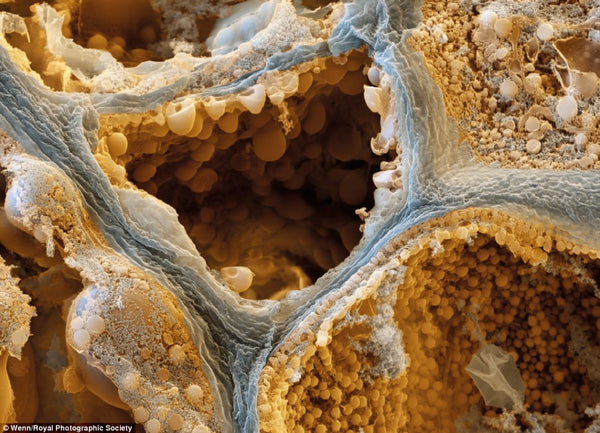
image sourced from Wenn/Royal Photography Society
Freeze Dried Coffee, also known as Instant Coffee
This image is actually of the micro-gas cells and cavities that occur when coffee is freeze dried. 
image sourced from Nestle
Caffeine
Oh, glorious caffeine. It definitely looks similar to how we feel after drinking it. 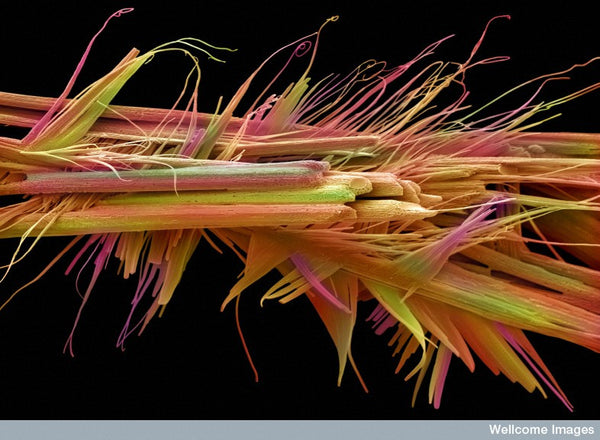
image sourced from Annie Cavanagh & David McCarthy @ Wellcome Image
Pièce de Résistance - The Espresso
This photograph won 9th place in the 2016 Nikon Small World competition, we think it should have come first. The espresso, which has dried in this image, looks spectacular! 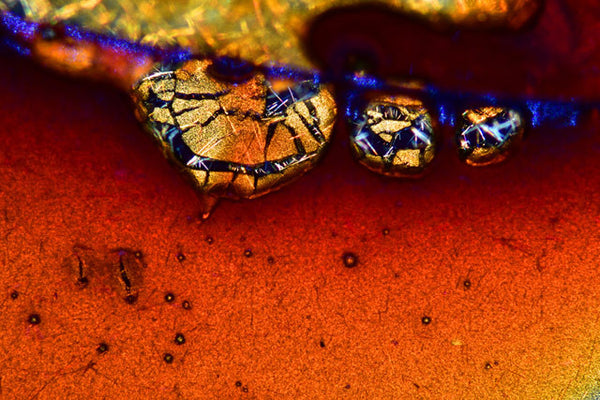
image sourced from Vin Kitayama & Sanae Kitayama.
Coffee is such an interesting commodity. Tiny little seeds that contain so much information and flavour. These microscopic images just help us appreciate the complexity and beauty of every form of coffee.
The chilling (not really... well maybe a little) story of decaf February 03 2017
Decaf doesn't get a lot of attention in the coffee world, but we here at Two Spots Coffee think it should. The bean must undergo quite a process to become decaffeinated. The caffeine basically, in its simplest terms needs to be washed out of the coffee.
The decaf beans that we use are Swiss Water washed. This particular method was invented in 1979 by Coffex. What this method means is that green beans (unroasted) are soaked in a green bean solution which extracts the caffeine, but retains the flavour of the bean. The beans are then removed from the liquid, washed and laid out to dry and follow the same process as caffeinated beans. The liquid that extracted all the caffeine is then passed through charcoal which removes the caffeine that came from the beans originally. The liquid can then be used to extract caffeine from another batch of beans.
However, in the early 2000's a lot of articles surfaced about GM trees that grew decaffeinated beans. That means that there would be no need for an extraction process on the beans. The story didn't begin there though. It originated in 1983 when Paulo Mazzafera, at the Agronomical Institue of Campinas (IAC) in Sao Paulo, Brazil set about finding a caffeine free coffee bean, his research will be discussed below.
A decade later, in 1992, John Stiles, a geneticist at the University of Hawaii in Honolulu wanted to create a way to stop specific proteins from growing in coffee plants, his particular target was caffeine. Over the next few decades he attempted to make caffeine free trees and often made bold claims about having discovered a caffeine free tree. He eventually left the University of Hawaii in 2000 and set up his own private lab. His private lab folded in 2008 and Stiles confessed that the was never 100% sure that he had in fact created a caffeine free tree.
Similarly, in 2001, Shinjiro Ogita started a study at the Nara Institute of Science and Technology in Tokyo, Japan which aimed to remove the enzyme that causes the occurrence of caffeine in coffee beans. To some extent he succeeded, the tests that were conducted on the leaves of his GM coffee tree had 70% less caffeine than a traditional coffee tree. The GM tree has yet to grow any seeds/coffee beans* though.
Paulo Mazzafera, who is mentioned above, started his research in 1983. He finally had a break through in 2003 when one of his samples tested as caffeine free. After this discovery the Brazilian government offered the research group he was a part of 1.2 million to continue their research in secret. The research could not be disclosed to anyone and the location was kept well under wraps. The aim was to eventually yield a breed that could be grown as crops and sold. However, the research became public in 2004 and the IAC soon took over Mazzafera's research and now he only plays a small role.
Mazzafera didn't give up though and in 2006 he soaked over 28.000 Arabica seedlings in a solution that causes mutation. He planted them and ended up with 7 plants that only have 2% of the caffeine a normal plant does. He has trademarked the beans as decaffito. Interestingly though, there are issues with mass producing these plants as some do not yield high enough number of cherries to be harvested. Another concern is cross pollination, when the trees are planted in the wild they may come in contact with caffeinated plants which might cause the caffeine to be reinstated in the trees.
So for now we will enjoy the lovely flavours of Swiss Water decaf, but we wait excitedly for the future of caffeine free trees.
*correct as of 2012, information on the tree as of 2017 could not be located.
The Riddler is now serving our coffee January 31 2017
 When we were asked to supply hand roasted coffee to The Riddler we couldn't have been happier. The concept and the connection to the Irish heritage blew us away. It was something we could relate to as we are both about high quality Irish ingredients. So in light of their recent opening we are proud to introduce The Riddler to the Two Spots family, be sure to visit them for a nice cup of Johnny Forty Coats and some of the amazing food they have.
When we were asked to supply hand roasted coffee to The Riddler we couldn't have been happier. The concept and the connection to the Irish heritage blew us away. It was something we could relate to as we are both about high quality Irish ingredients. So in light of their recent opening we are proud to introduce The Riddler to the Two Spots family, be sure to visit them for a nice cup of Johnny Forty Coats and some of the amazing food they have.
The concept was developed by Keith McDonnell and focuses on his love of Ireland. He wanted to be able to use the local resources to produce in season quality food that is inspired by dishes Irish parents would have served throughout the years.
The Riddler, located in the La Rochelle Building, High Street, Christchurch, Dublin 8 (right beside the Old Dublin City Wall), provides Bia Bhaile, their chefs pride themselves on producing innovative modern Irish dishes utilising fresh, locally-sourced, seasonal ingredients. The liquors are all distilled in Ireland and the coffee is supplied by yours truly.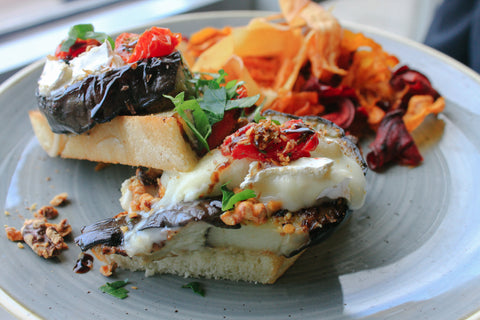
 The Riddler is not just about Irish food though, but about connecting or reconnecting with Irish roots.
The Riddler is not just about Irish food though, but about connecting or reconnecting with Irish roots.
There are numerous mentions and nods to Irish traditions, media, culture. Additionally Ireland's landscape gives them much inspiration which is reflected in all of their dishes and decor. The space that The Riddler is in was an abandoned furniture store, the space was overhauled with herringbone parquet flooring, a full kitchen and a wood riddle feature wall. It was created with the neighbourhood in mind and it is a place where people feel welcome, eat well and maybe solve a riddle or two.
The staff are super friendly to boot and all of us here at Two Spots Coffee had a blast getting to know them. Don't just take it from us though, pop in and experience it for yourself.
They are currently serving breakfast, brunch and lunch as well as delicious coffee. Their opening hours are:
Mon - Fri: 7.00am - 3.00pm
Sat-Sun : 10.00am - 3.00pm  They will be opening for dinner in the coming months as they develop a stunning dinner menu.
They will be opening for dinner in the coming months as they develop a stunning dinner menu.
To stay up-to-date with them, follow them on Facebook at The Riddler or on Instagram/Twitter with @theriddlerdub.
Web: www.theriddler.ie
Phone: 01 907 3266
Email: info@theriddler.ie
Reduced Shipping Prices, Product Galore and 10% Discount On All Products. Have we lost it?!? January 26 2017
As the site officially opens again we would like to inform all of our customers of the changes that have occurred.
We have reduced our shipping prices: That means that you will only pay a flat rate of either 4 or 5 euro (depending on which you choose) on any orders up to 10kg. Wahey!!
The addition of single origin: We will be supplying single origin in the store with a new addition every month. The single origin for January 2017 is Yirgacheffe - find out more about this interesting bean here
Equipment for all your needs: We have added an array of equipment that you can use to brew your coffee. See all our equipment here
We have also supplied a discount until the 2nd of Feb 2017. Use the promo code
TSCOFFEE
and get your orders in asap.
Feel free to roam around the website and as always; email us if you have any queries.
Due to the current economic climate adjustments have had to be made on the prices of our blends.
Maintenance Notice January 23 2017
We will be doing maintenance on the website on the 26th of January 2017 from 10 a.m. til 5 p.m. The website will be inaccessible during that time and will resume at 5 p.m.
The maintenance will include an update of prices (including shipping costs), the availability of equipment and an introduction to single origin.
If you need to contact us urgently during that time please email us on info@twospotscoffee.ie or call Stuart on +353 87 998 5320Deliveries and Opening Hours over the Christmas Holidays December 16 2016
As Christmas nears we would like to remind all of our customers that pre-Christmas orders of hand roasted coffee need to be placed before 1 pm on Wednesday the 21st of December. The orders will be dispatched on the same day and delivered to you before the 25th of December.
UK customers should place their pre-Christmas orders before 1 pm on Monday the 19th of December.
Please note that we will close on Friday the 23rd of December and will reopen on Tuesday the 3rd of January.
Merry Christmas and a Happy New Year from all of us at Two Spots Coffee.
Roasting Process July 28 2016
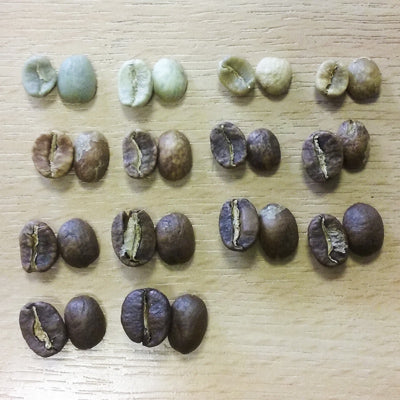
The actual method of roasting coffee can be overlooked at times. Especially when there is such great emphasis on the barista skills required to extract that beautiful espresso. However the taste of that espresso is in large dominated by the roast profile, as it is the determining factor on what flavours are present. The roast profile refers to how the coffee is roasted, what temperature it is roasted at and most importantly when the roasting process is stopped.
In order to understand the different roasts we must first begin to understand what actually happens to the coffee during roasting. The beans go through phases of being endothermic (absorbing heat) and exothermic (exporting heat) which causes them to crack. The beans don't actually break but they make a sound similar to popcorn and will approximately double in size over the roasting process. The beans can crack twice, referred to as first crack and second crack respectively. Most roasters will allow the first crack to completely finish and will rarely roast until the finish of the second crack. Soon after the second crack finishes the beans begin to burn and eventually disintegrate in to ash or cause a fire! You can find out more about the endothermic and exothermic process in our previous blog here.
Below you can see the different stages of roasting, from green bean to Full City+ Roast. The beans that are being hand roasted in the pictures below are from Guatemala and can be found in Bang Bang, Skin the Goat and Johnny Forty Coats.
The lovely signs indicating the time were made with the help of our youngest team member.
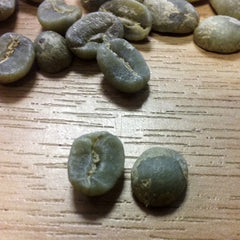
Green Bean
This is the bean un-roasted and raw. The bean is very hard and small. During the roasting process the bean will soften and grow in size.

@ 4.00 minutes
The bean goes from a green colour to a pale green colour. In terms of colour the bean does not change much during this stage. However during this endothermic stage the bean releases water.

@ 6.00 minutes
The bean goes from pale green to a yellowing colour. There is no change in the physical size of the bean.
@ 6.30 minutes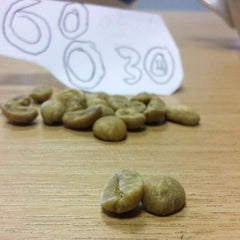
The bean begins to gain a tan colour and is still letting off water in the form of steam.
@ 8.00 minutes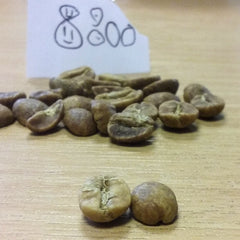
The coffee bean turns from a tan colour to a light brown. The first crack is nearing and the bean starts to expand in size. The browning and aroma occurs due to Maillard reaction where the protein in the coffee combines with the sugar and creates aromatic compounds.

@ 9.00 minutes
The bean has now turned a deeper brown and the first crack will occur within the next minute.
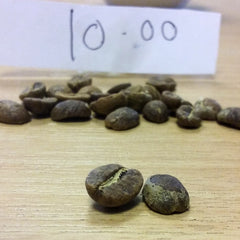
@ 10.00 minutes
The first audible sounds of the first crack can be heard. This is where the bean stops being endothermic and becomes exothermic, it stops absorbing heat and instead gives off heat as the bean cracks. If the roast is stopped here it is considered a Light City Roast or a Cinnamon Roast. The acidity in this roast is very pronounced and it has a grainy taste
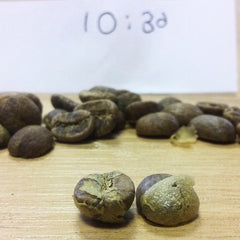
@ 10.30 minutes
The first crack continues. The beans will not have a uniform colour at this stage, but will start visibly expanding in size.

@ 11.00 minutes
Once the beans stop cracking they become endothermic again and start absorbing heat. This is in preparation for the second crack. 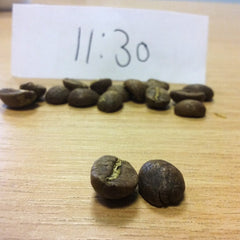 @ 11.30 minutes
@ 11.30 minutes
During this period the bean's surface begins to smooth and the colour becomes more uniform. If the roasting process is stopped here the roast is considered a City Roast or an American Roast. This is considered a medium roast and there is balance of flavour, aroma and acidity but it lacks body. 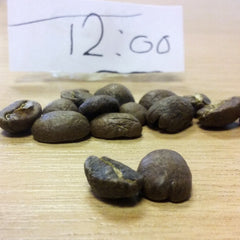 @ 12.00 minutes
@ 12.00 minutes
The length of time between the first crack and the second crack really depends on the person roasting and the specifications of the roast. In some cases the time between the first and the second crack can be a as short as 30 seconds. However the time can be controlled by adjusting the temperature inside the roaster. 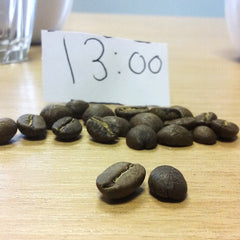 @ 13.00 minutes
@ 13.00 minutes
This is the time just before the second crack. There are no audible signs of the second crack yet, but judging by the temperature the person roasting knows that the second crack is due any second. If the roasting process is stopped here the roast is considered a Full City Roast.
@ 13.30 minutes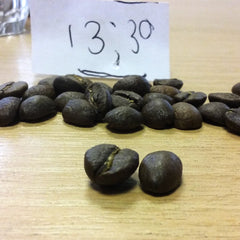
The first audible signs of the second crack become apparent. The beans have at this stage gained a uniform rich brown colour and have almost doubled in size from the green bean. The roasting process for the Guatemalan bean is stopped here and is considered a Full City+ Roast. This is a medium dark roast that has a heavy body in comparison to the previous roasts. The beans are poured out on to a cooling tray and moved around to get the roast to cool down evenly.
If the roasting process is continued a Vienna Roast, French Roast and Espresso Roast can be achieved, to name a few. Both of these roasts are achieved during the second crack. Once the second crack has completely finished the coffee bean has become over a quarter ash and completely unusable. Well, it can probably still be used but it won't be a pleasant experience. Any further roasting will cause the beans to give off smoke and eventually cause a fire. We did not document this process of further roasting for obvious reasons.
The roasting process will vary depending on the person roasting and what they are trying to achieve with the roast. An important factor to consider though is that the temperature controls exactly how long the roast takes and what is achieved. If the temperature is too high there is a chance that the beans will just burn immediately. Additionally if the temperature is too low the beans will not roast properly. Roasting coffee really is a balancing act of ensuring that the temperature is high enough to roast the coffee, but not so high that it burns it.
Once the roast has finished it will be used either in a coffee blend or packaged as a single origin. The roasting process has been done to draw the best flavours out of the bean so you can enjoy every single cup.
Ever wondered what it takes March 23 2016
Have you ever wondered what it actually takes to make a cup of coffee?
We know that it can seem simple, seeing that once you are in a cafe all it takes is a few minutes and you have coffee that is ready to drink. One that hopefully makes the day seem brighter.
But getting the coffee to you is actually a lengthy process because as we all know, you can't rush perfection.
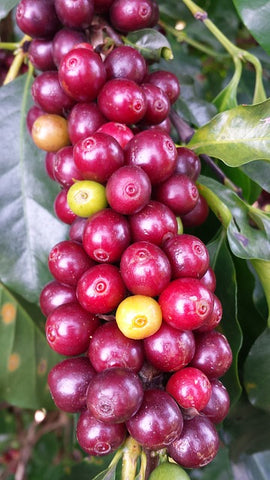 The whole process begins when the coffee tree is planted. Once it has been planted it takes about 3-4 years for the tree to produce the coffee cherry. This fruit contains the coffee bean, which is actually a seed and not a bean. When it is ripe the cherry turns a deep, bright red and is ready to be picked. Each individual cherry is then picked off the tree, this is often done by hand and is a tedious process.
The whole process begins when the coffee tree is planted. Once it has been planted it takes about 3-4 years for the tree to produce the coffee cherry. This fruit contains the coffee bean, which is actually a seed and not a bean. When it is ripe the cherry turns a deep, bright red and is ready to be picked. Each individual cherry is then picked off the tree, this is often done by hand and is a tedious process.
The cherries must be processed as soon as possible to prevent them from spoiling. This is done by two main methods:
-
The Dry Method
The cherries are spread out and left to dry in the sun while being regularly rotated. They are also covered during the night and during rain. This is done until the moisture content of the cherry drops to 11% and this can take up to 4 weeks. The cherries are then hulled where the skin and pulp are removed in one step and the bean is the only thing left. -
The Wet Method
First the cherries are passed through a pulping machine where the skin and pulp are separated from the bean. The beans are then passed through water channels and are separated by weight and size. The beans are then placed in a water filled fermentation tank and are left there for 12-48 hours. After the fermentation period the beans are washed and dried until their moisture content reaches 11%.
The beans are then milled. Regardless of the processing method the beans are hulled, polished, graded and sorted. The beans go through a rigorous inspection process of the colour and any imperfections. They are then sorted by size and weight and exported.
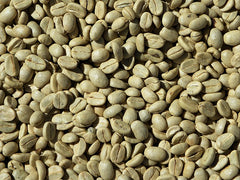 50 kg of cherries produces about 10 kg of green beans that then need to be roasted.
50 kg of cherries produces about 10 kg of green beans that then need to be roasted.
Here at Two Spots we source beans from all over the world, including Brazil, Honduras, Guatemala, Ethiopia, Papua New Guinea and India. So you can imagine the journey the beans took to reach your cup.
Roasting is the final stage in prepping the bean for consumption. Roasting is a very tricky process that requires constant attention. It consists of two main stages that are repeated depending on what type of roast is desired:
- Endothermic
In the beginning of the roast the beans are endothermic, what that means is that the beans absorb the heat within the roaster. This is where the beans start to change colour from green to a golden brown. -
Exothermic
This means that the beans release heat instead of absorbing it. This is where the "first crack" happens. The beans reach their optimal heat and crack which causes them to expand and double in size. Some roasts will only progress to the first crack which produces a light roast and then go to the cooling stage. -
Endothermic (again)
This period of the beans absorbing heat again is very short, less than a minute. But it sets the beans up for cracking again. -
Exothermic (again)
The "second crack" happens which signals that the beans have been dark roasted. However, the roasting period after the second crack can vary depending on what type of roast is being produced. -
Cooling
Once the beans have been roasted to the desired level they must be cooled quickly otherwise the beans will continue to "cook". This is usually done by circulating the beans while using fans.
During the roasting process the beans lose approximately 18% of their moisture or weight.
What started out as 50 kg of coffee cherries produces 10 kg of green beans and after roasting provides only 8.2 kg of coffee. Beans from different origins are then mixed together in specific quantities to create a blend that is then brought to the cafes.
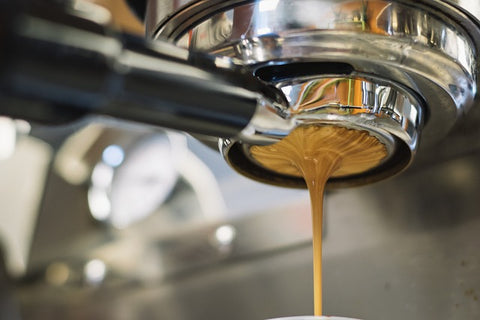
It doesn't end there though, once delivered to the cafes the barista needs to follow a specific process to ensure that the extraction of the coffee produces the optimal flavours and aromas. There are many factors that contribute to this including:
-
The Grind
The barista must make sure that the grind of the coffee feels like a mixture between powdered sugar and sand. -
Dosage
On average 20 gr of ground coffee is used to make a double espresso. Although this may vary depending on the cafe/brand. -
Tamping
Once the coffee has been placed in the basket about 18kg of pressure must be applied to compress the coffee. -
Extraction
The coffee is then extracted by a machine at 9 bars, which is 9 times the atmospheric pressure at sea level. -
Serving
Depending on the drink you order the barista will then foam milk and serve a delicious cup of coffee.
It is a truly amazing adventure that the coffee goes on to make it to your cup. Just imagine, the coffee you had today could have possibly taken 4 years to get to you.
Needless to say, we're in love with the process.
What is cupping? October 24 2014
A while back a customer asked us what cupping was. So just to explain we are not going mad or doing any magic tricks with our coffees. Cupping is a process used by us coffee heads (mainly roasters) to analyse each of our coffees different profiles and characteristics. In lay mans terms it consists of grinding some coffee, putting them in glasses or bowls, adding some hot water and then slurping the coffee around inside the mouth to get all of the flavours.
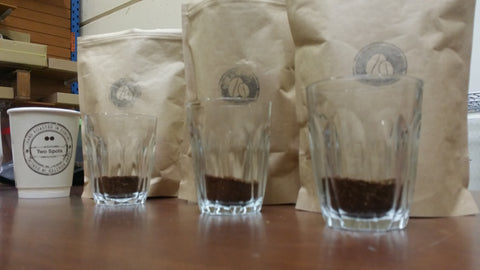
However it is a more consistent and accurate process than just this and is used by Roasters throughout the world in order to keep the evaluation of coffees the same. This way we have a better idea of how any coffee would score in terms of taste, flavours and aromas. We constantly use this to improve and provide the best quality coffees to our customers as possible. We are currently searching and assessing some of the best coffees throughout the world so look out as we hope to have them available soon.
We are way out in front! September 30 2014

Check out this great review from the folks over at NorthSouth139
First thing’s first, originality of branding, coffee names etc, these guys are way out in front! This is a good example of looking at branding and thinking “That sounds unique and original, I want one of those!” But the proof is in the pudding, so how does this blend stack up?
Usually, the first moment when I start to decide on what a coffee is like, is from the smell of it as it sits in my little Bodum press. Johnny Forty Coats (lets just call it JFC for this!) has a very new aroma. It’s a long way from the usual dark roasts that I go for, but in a good way! The aroma instantly reminds me of one of those cool new coffee places that is also an antiques shop and an art gallery. Cool, original, but you know there’s thought gone into it. So, biscuits at the ready, gave it a press and tucked in ...read the full review here
Dublin Coffee and Tea Festival 2014 September 19 2014

A huge thank you to all the coffee lovers & trade out there who came to visit Two Spots Coffee at the Dublin Coffee and Tea Festival Sept 2014. We hope you enjoyed hearing about Two Spots, tasting our unique single origin roasts & reviving those old Dublin characters in the form of our coffee blends-Skin the goat,Bang Bang & Johnny Forty Coats. Watch out for Two Spots at future events & thanks for all the support.
Have a listen to what the good folks from the sodshow had to say about the ‘Dublin Coffee Tea Festival 2014’ on Audioboo
Perk yourself up July 30 2014

On the go slow, just out of bed and in zombie mode heading into work? The lids are still heavy and your tryin to recall that dream, was it an adventure?
You can't really remember, still confused on auto pilot wish you'd had 5 more minutes
Perk up by treating yourself to our famous Two Spots Coffee Bang Bang' blend.
You know that silky and smooth texture of a 100% arabica hand roasted coffee... drop into our newly opened Two Spots Café in Boroimhe Shopping Centre, Swords, Co.Dublin and ask Aoife for one.
